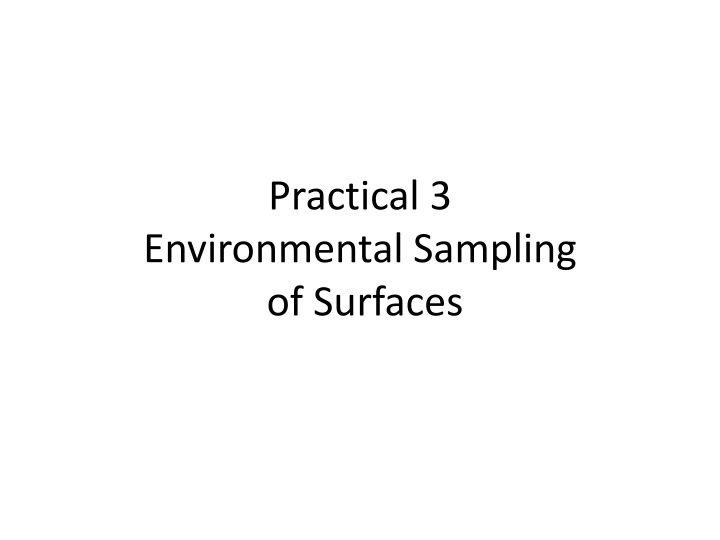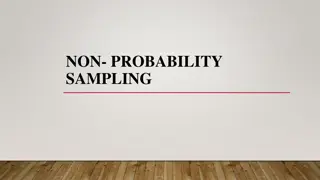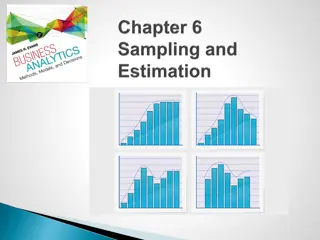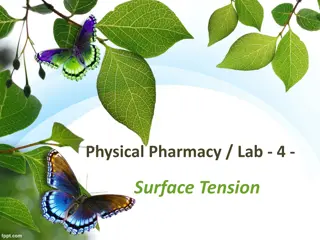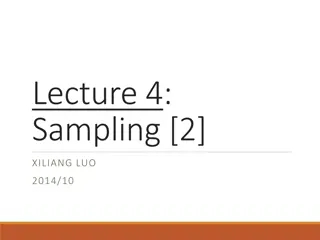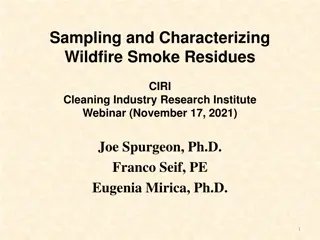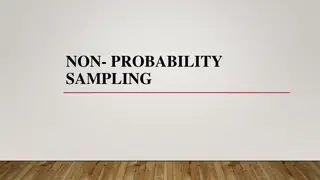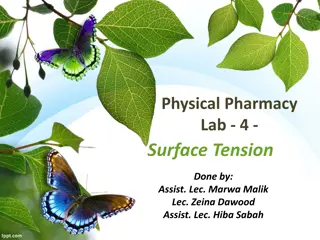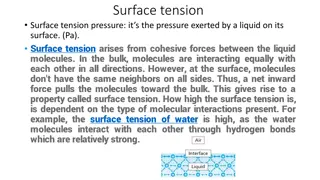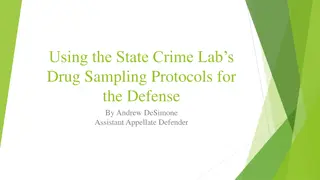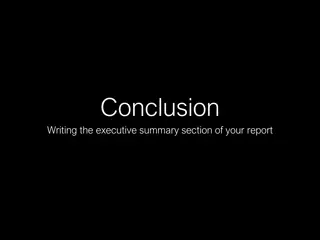Guide to Environmental Surface Sampling Techniques
Understanding the importance of environmental surface sampling is crucial for ensuring hygiene and safety. This guide covers key aspects such as pre-sampling considerations, aseptic techniques, major sampling methods like RODAC plate, swab, and wipe methods, along with detailed procedures for each method. It emphasizes the significance of disinfectant neutralizers, proper asepsis, and strategic sampling planning for obtaining accurate and reliable results.
Download Presentation

Please find below an Image/Link to download the presentation.
The content on the website is provided AS IS for your information and personal use only. It may not be sold, licensed, or shared on other websites without obtaining consent from the author.If you encounter any issues during the download, it is possible that the publisher has removed the file from their server.
You are allowed to download the files provided on this website for personal or commercial use, subject to the condition that they are used lawfully. All files are the property of their respective owners.
The content on the website is provided AS IS for your information and personal use only. It may not be sold, licensed, or shared on other websites without obtaining consent from the author.
E N D
Presentation Transcript
Practical 3 Environmental Sampling of Surfaces
Things to Consider Prior to Surface Sampling Background literature and present activities Preliminary results from epidemiological investigation Locations to sample Collection method and equipment Number of replicate samples needed Are controls or comparisons needed? Parameters for assay; qualitative, quantitative, or both? Estimate of maximum allowable microbial numbers or types on surface(s) sampled Some anticipation of a plan of action based on results
Things to Consider Before Conducting Surface Sampling Asepsis is critical Sterilized sampling materials Aseptic technique Document the circumstances of sampling State of the surface and its preparation, if any, prior to sampling Prepare a sampling strategy or plan that ensures the validity of the results and is appropriate for the organism(s) being sampled
Environmental Surface Sampling Disinfectant neutralizers may be needed Major methods include: RODAC plate (direct surface sampling) Swab method Wipe method
RODAC Plate Sampling Method Materials used: RODAC plate : agar medium is overfilled to give a convex surface(Replicate organism detection and counting) Used to sample cleaned flat surfaces; not suitable for visibly dirty or irregular surfaces Neutralizers can be incorporated into the medium if surface disinfectant residuals are present Press the convex medium onto the surface; do not twist or move the plate around
Swab Sampling Procedure Materials used: Sterile items: gloves, sample containers (e.g., large tubes), wrapped non-cotton swabs, wetting solution, scissors, sealable plastic bags, markers, tags Wet the swab and wipe using an S- shaped pattern (vertically & horizontally), rolling the swab over the surface Place the swab aseptically in a sample tube; label
Wipe Method Materials used: Sterile gloves, sterile sample containers, sterile wrapped 2x2 gauze sponge pads, sterile water or saline, plastic bags, tags Aseptically wet the gauze with fluid and thoroughly wipe the area within the template Fold the gauze so the exposed side is inward and place in sample container; label
Compare and Contrast Surface Sampling Methods Sample Type Biological Agents Description Target Uses Sterile 2 x 2 non- cotton gauze, moistened; wipe area of known size Nonporous surfaces, usually small in area Wipe Bacteria, fungi, biological toxins Sterile non-cotton swab, individually wrapped, then moistened with sterile solution; wipe area of known size Nonporous surfaces, usually very small in area, complex surfaces with crevices, corners Screening small nonporous surfaces extent of contamination decontamination effectiveness Swab Convex agar surface in culture dish, press onto surface, incubate Nonporous surfaces, relatively small area ,f lat Bacteria, fungi RODAC
Other Methods of Sampling 1-Direct Microscopic Examination A direct microscopic examination of a surface shows exactly what is there, without being affected by an organism's ability to compete and grow on sampling media. Advantages of direct microscopic test is inexpensive and may be analyzed immediately. shows exactly what is there without being affected by an organism's ability to compete and grow on sampling media.. may reveal indoor reservoirs of spores of fungi which have not yet become airborne.
2-Tape Sample Use a piece of absolutely clear tape that is one or two inches in length. Handle it by the ends only. Position the adhesive side of the tape over the suspect area and press firmly, do not rub the tape back and forth. Remove the tape from the surface and place it onto a clean microscope slide, then place the microscope slides into a slide box or other protective container. If microscope slides aren't available, tape the tape sample directly onto a plastic bag adhesive side down. Do not fold the tape onto itself.
Visual Methods Currently Used to Teach and Evaluate Cleaning Practices Application of clear chemicals that fluoresce under UV light : GLO Germ The GLO Germ Kit contains a bottle of liquid or gel, a bottle of powder, and an ultra-violet lamp. The liquid or gel and the powder contain the plastic simulated germs, and the lamp illuminates them to test the effectiveness of cleaning practices.
GLO Germ GLO Germ is the world leader in demonstrating cross-contamination issues in food service, health care and educational markets. GLO Germ stands out as an effective way to show just how easy it is to overlook proper hand washing and cleaning. Not enough can be said about how important cleanliness and proper hand washing are to keep infections from being spread.
Practical work Each 3 students will have 3 PCA plates Label plates as clean , moderate , dirty , student name ,name of surface. Swab surface with sterile swab after pre wetting in S.Saline, by rubbing slowly firmly back and forth at 3 times over a certain area. Inoculate the labeled plate with swab. Incubate plates 48hours at 37 c Read results with instructor.
Reading of results Determine the type and number of organisms An accountable plate is one which contains from 30-300 colonies An acceptable plate is one containing less than 100 colonies for moderate and dirty surfaces and sanitation is said to be acceptable. For clean surfaces account of less than 20 colonies is said to acceptable. If a there is a Predominant organism , this is not normal .It needs investigation.
